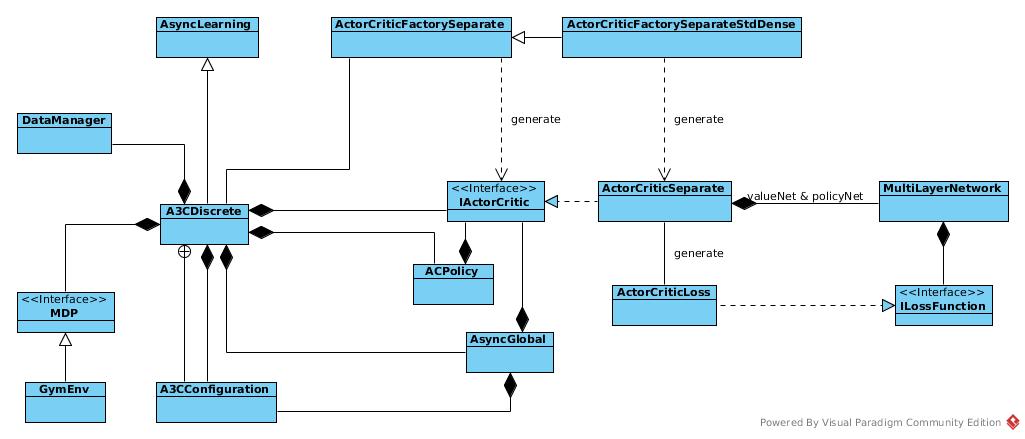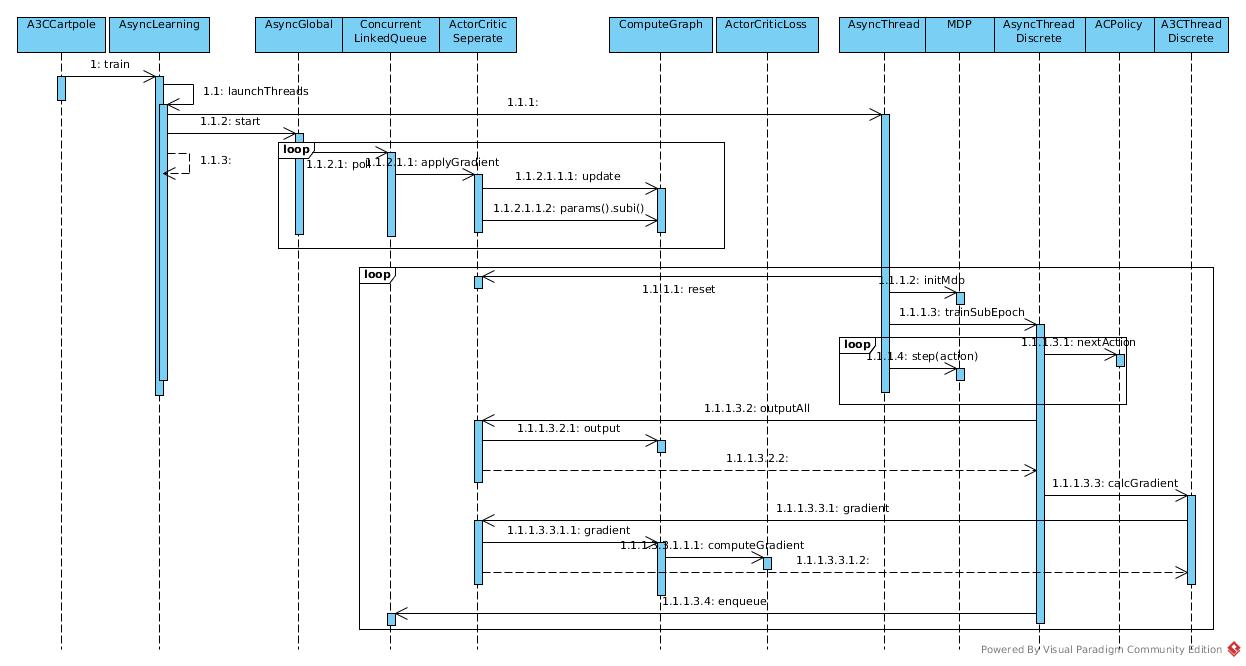A3C Cartepole
The figures in this link explain what A3C is doing. Simple Reinforcement Learning with Tensorflow Part 8: Asynchronous Actor-Critic Agents (A3C)
Architecture

Sequence

Calculation
In this example, value net and policy net are two independent NN, and they are treated independently
Global Thread
AsyncGlobal polls the queue and updates the network timely. Then update target network in some condition in double NN case
public void run() {
while (!isTrainingComplete() && running) {
if (!queue.isEmpty()) {
Pair<Gradient[], Integer> pair = queue.poll();
T.addAndGet(pair.getSecond());
Gradient[] gradient = pair.getFirst();
synchronized (this) {
current.applyGradient(gradient, pair.getSecond());
}
if (a3cc.getTargetDqnUpdateFreq() != -1
&& T.get() / a3cc.getTargetDqnUpdateFreq() > (T.get() - pair.getSecond())
/ a3cc.getTargetDqnUpdateFreq()) {
log.info("TARGET UPDATE at T = " + T.get());
synchronized (this) {
target.copy(current);
}
}
}
}
}
Workers send gradients for value net and policy net as an array and update them accordingly
ActorCriticSeparate.applyGradient(Gradient[] gradient, int batchSize) {
MultiLayerConfiguration valueConf = valueNet.getLayerWiseConfigurations();
int valueIterationCount = valueConf.getIterationCount();
valueNet.getUpdater().update(valueNet, gradient[0], valueIterationCount, batchSize);
valueNet.params().subi(gradient[0].gradient());
Collection<IterationListener> valueIterationListeners = valueNet.getListeners();
if (valueIterationListeners != null && valueIterationListeners.size() > 0) {
for (IterationListener listener : valueIterationListeners) {
listener.iterationDone(valueNet, valueIterationCount);
}
}
valueConf.setIterationCount(valueIterationCount + 1);
MultiLayerConfiguration policyConf = policyNet.getLayerWiseConfigurations();
int policyIterationCount = policyConf.getIterationCount();
policyNet.getUpdater().update(policyNet, gradient[1], policyIterationCount, batchSize);
policyNet.params().subi(gradient[1].gradient());
Collection<IterationListener> policyIterationListeners = policyNet.getListeners();
if (policyIterationListeners != null && policyIterationListeners.size() > 0) {
for (IterationListener listener : policyIterationListeners) {
listener.iterationDone(policyNet, policyIterationCount);
}
}
policyConf.setIterationCount(policyIterationCount + 1);
}
The updater for both of them are initiated in ActorCriticFactorySeparateStdDense.buildActorCritic() as default updater: Adam
Worker Thread
The worker is running in similar way as DQN does. There are three minor differences:
- Networks are not updated in worker. Workers make use of network while not train them
- We are training V instead of Q, so the labels for value network is simple reward, not something about next state.
About above differences, they could be proved in *.trainSubEpoch() and A3CThreadDiscrete.calcGradient()
The last one is a special loss function for policy network which implemented as ActorCriticLoss
ActorCriticLoss
public INDArray computeGradient(INDArray labels, INDArray preOutput, IActivation activationFn, INDArray mask) {
INDArray output = activationFn.getActivation(preOutput.dup(), true).addi(1e-5);
INDArray logOutput = Transforms.log(output, true);
INDArray entropyDev = logOutput.addi(1);
INDArray dLda = output.rdivi(labels).subi(entropyDev.muli(BETA)).negi();
INDArray grad = activationFn.backprop(preOutput, dLda).getFirst();
if (mask != null) {
LossUtil.applyMask(grad, mask);
}
return grad;
}
As declared in reference, the loss function is L = log(π)(R - V) + BETA * H(π)
Make A = R - V
π is output of policy network, θ is W in previous networks descriptions.
Get π and log(π)
INDArray output = activationFn.getActivation(preOutput.dup(), true).addi(1e-5);
INDArray logOutput = Transforms.log(output, true);
Get (- d(H) / d(π))
H(π) = - (Σπi * log(πi))
d(H) / d(πi) = (1 + log(πi))
INDArray entropyDev = logOutput.addi(1);
Get d(L) / d(π)
d(L) / d(πi) = A / πi - (1 + log(πi))
A are labels computed in trainSubEpoch
INDArray dLda = output.rdivi(labels).subi(entropyDev.muli(BETA)).negi();
d(L) / d(θ) = (d(L) / d(π)) * (d(π) / d(θ))
In following sentence, backprop is doing this job and dLda is d(L) / d(π)
INDArray grad = activationFn.backprop(preOutput, dLda).getFirst();